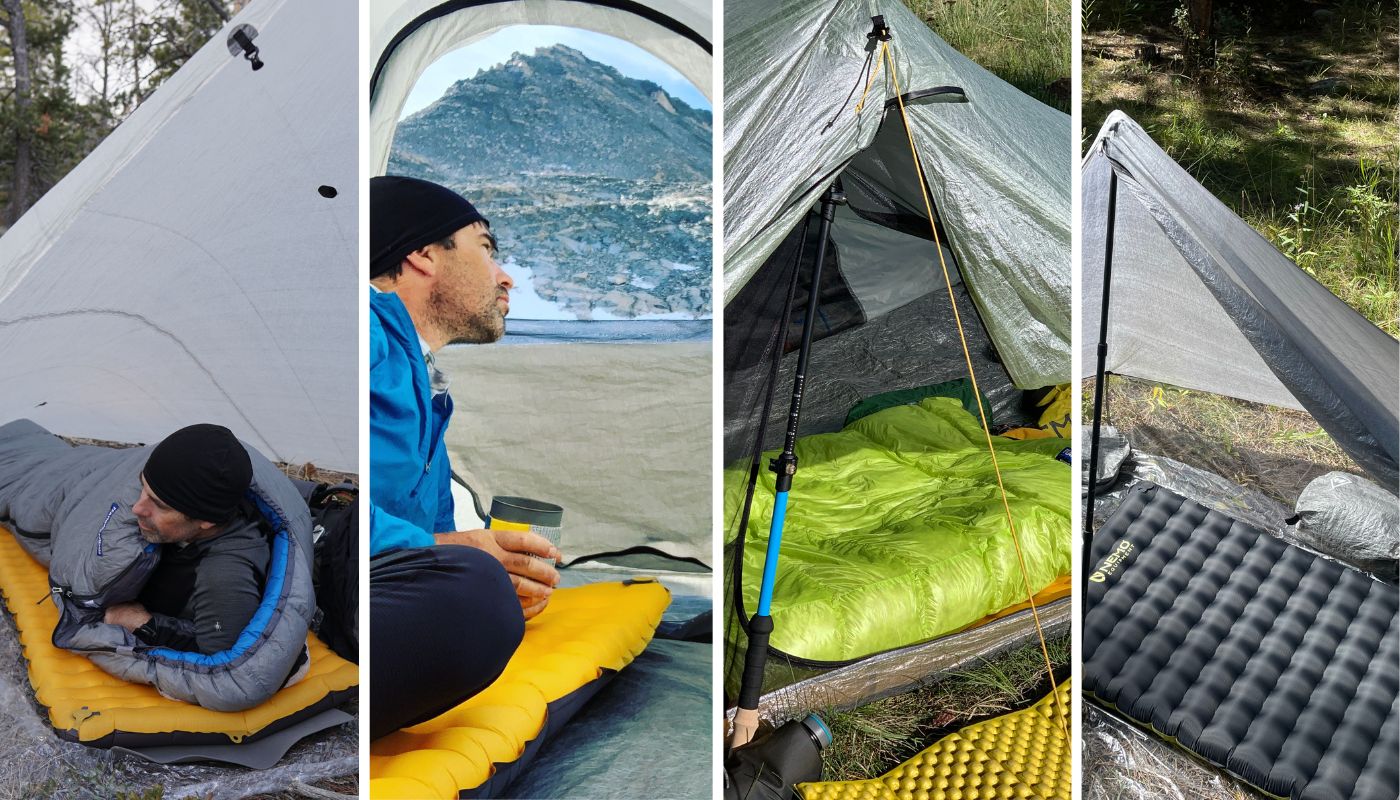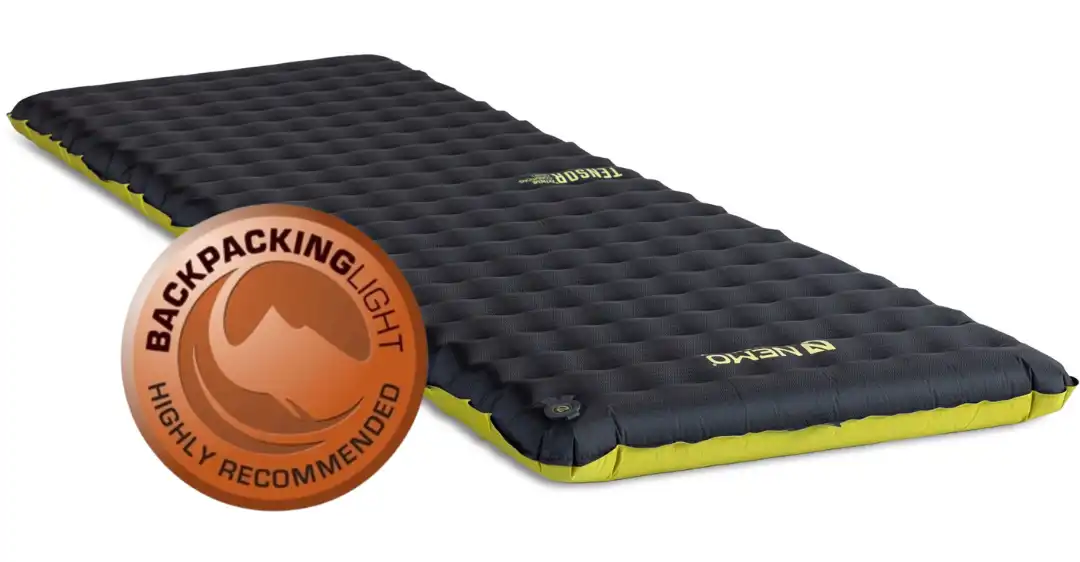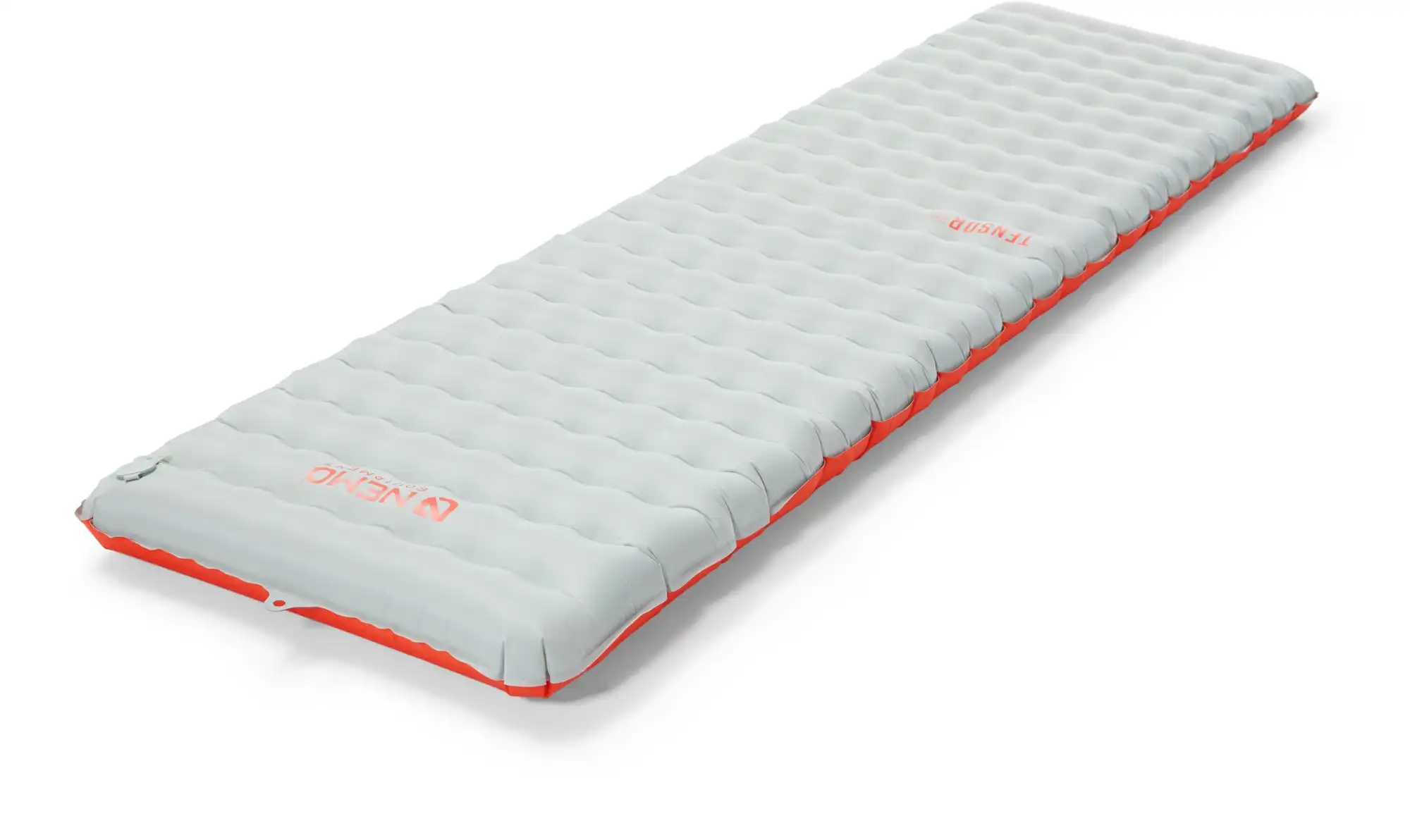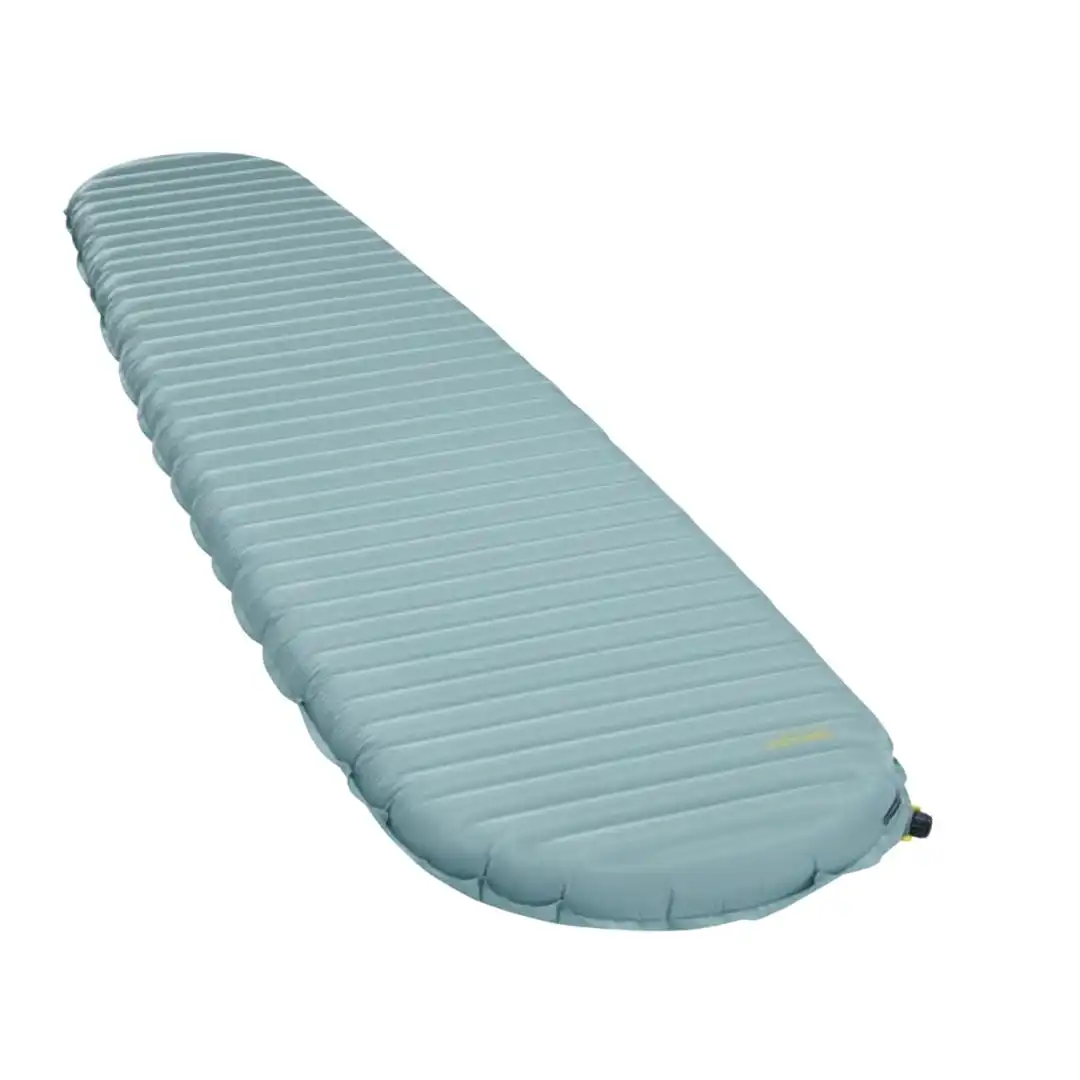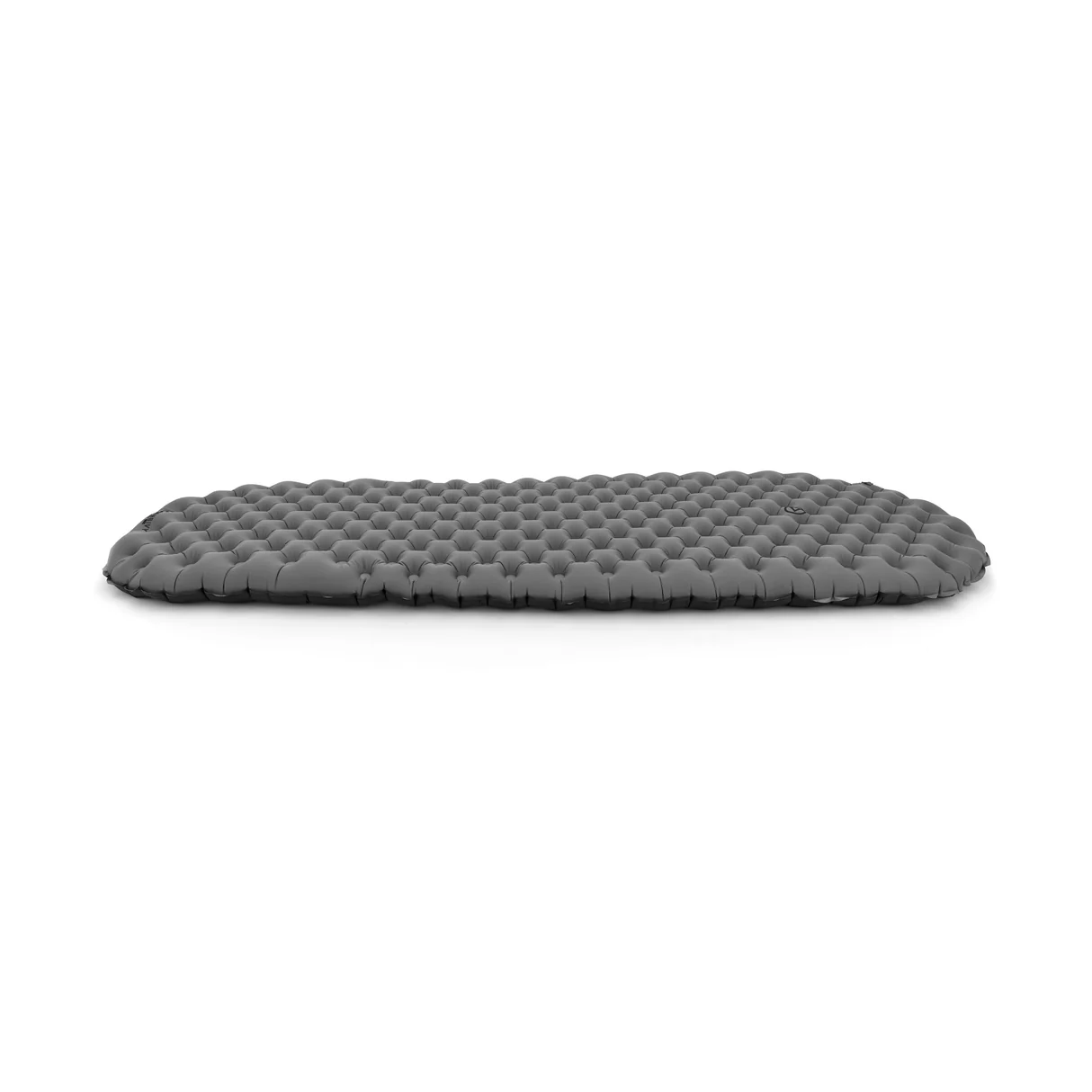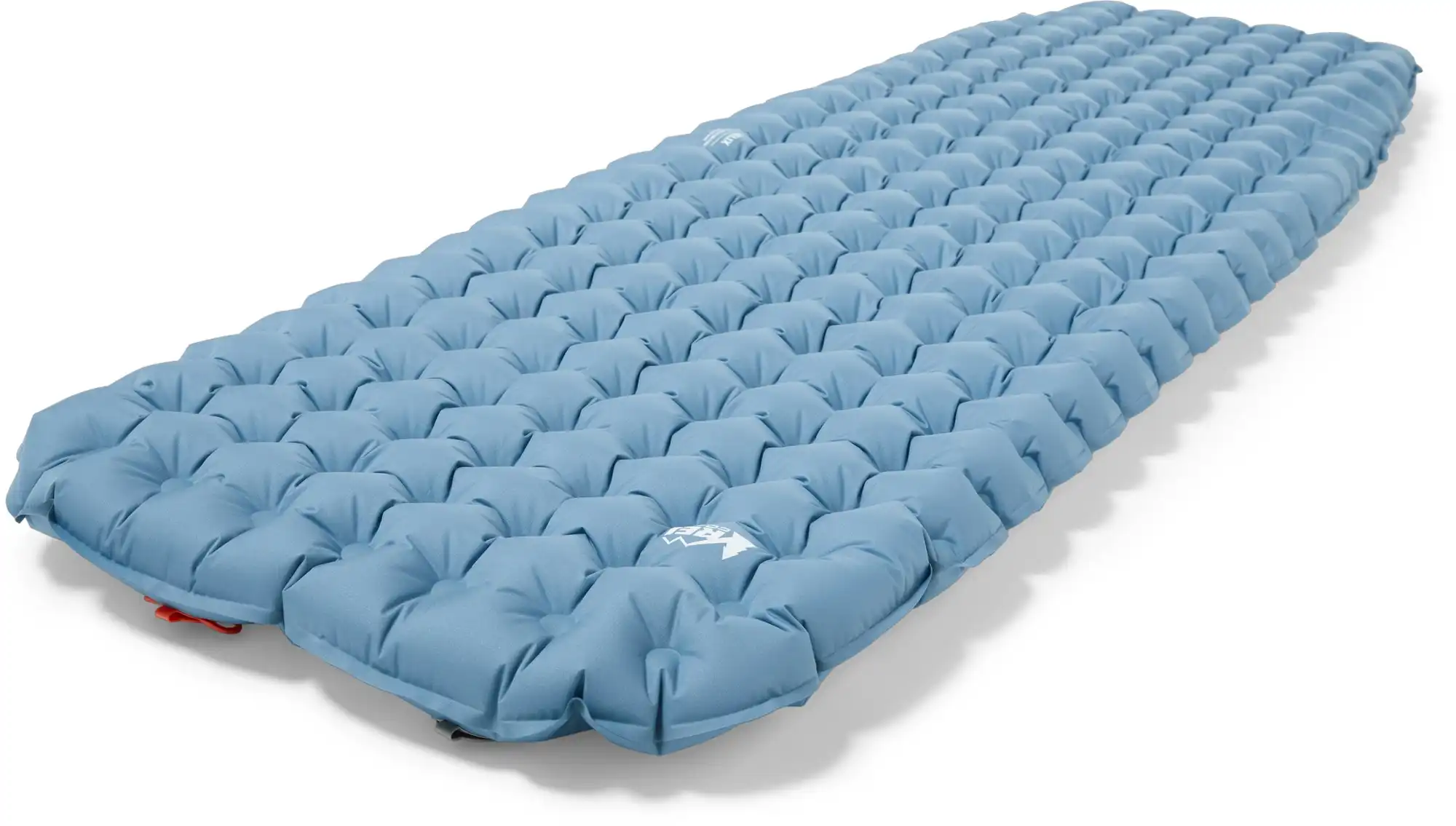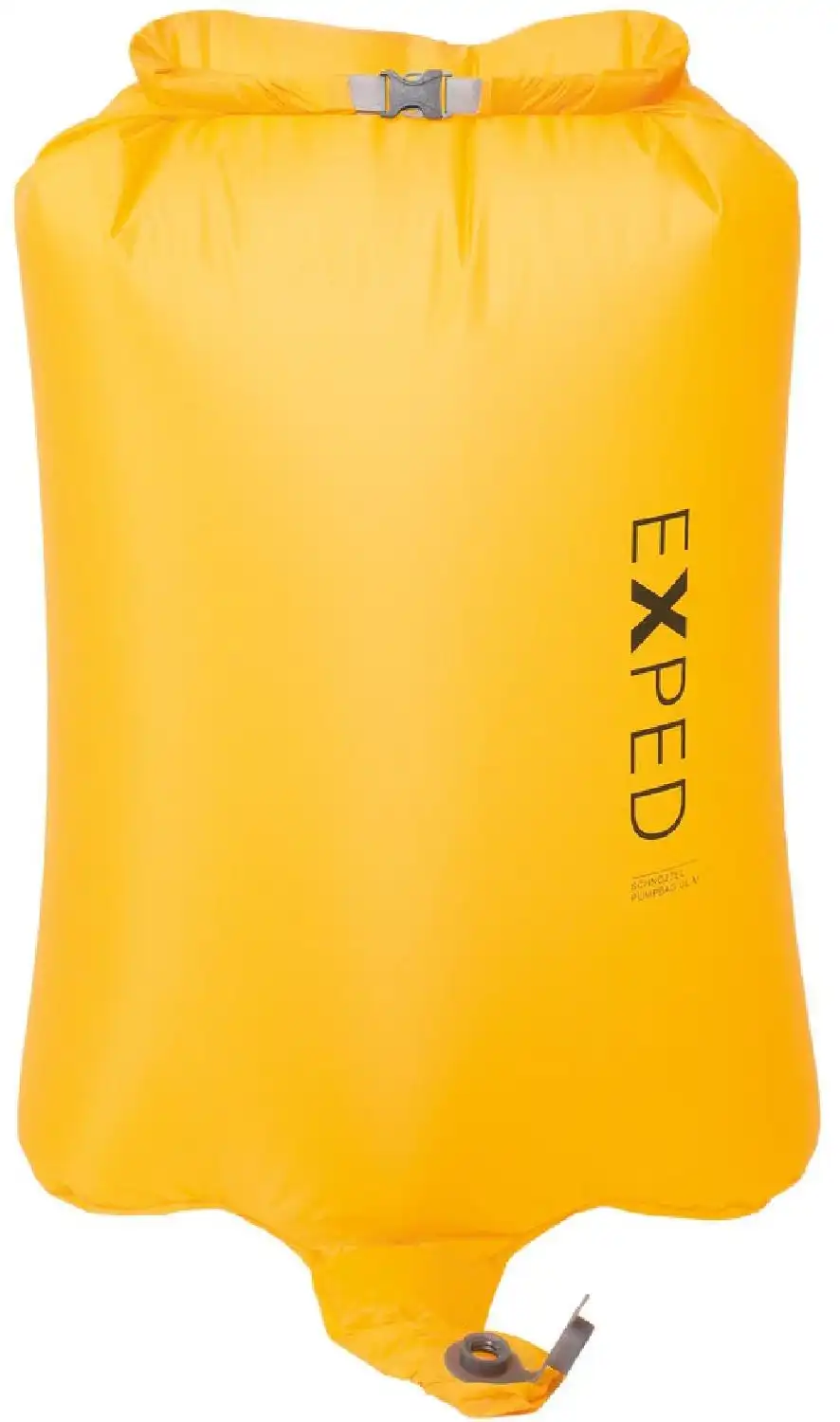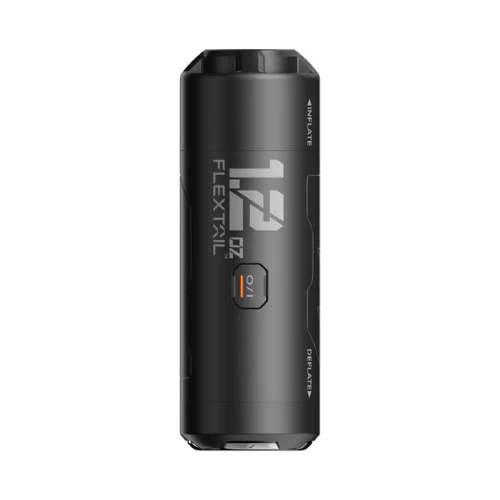Changelog:
- November 24, 2024 – Updated to include market research about sleeping pad performance vs. weight and value (see the new section “State of the Market: Inflatable Air Pads” below.
- August 27, 2024 – Introduction revised and expanded to include more accurate historical context; current model season pad specs and features updated; additional pads discussed, including modern closed-cell foam and inflatable pads with reflective insulation; budget section added; pad inflation device section expanded to reflect new products on the market.
Introduction: it all starts with closed-cell foam
My first sleeping mat was blue and made of cross-linked polyolefin. It weighed about half a pound (a quarter kilo) and cost $6. I purchased it from a military supply store using my allowance when I was 9 years old when I was getting ready for a Cub Scout sleepaway camp. I never had to repair it, because it was made with closed-cell foam – there was nothing to break.
The sleeping pad I used on my last backpacking trip weighs nearly three times as much, costs nearly forty times as much, and requires that I carry a patch kit (which I’ve used on nearly every inflatable pad I’ve ever owned).
Few pieces of gear can be contrasted as much as the sleeping pad I used when I was a child vs. the sleeping pad I use today. Very little (and at the same time, a lot) has changed during this 45-year journey.
That ultralight blue foam pad represented (for me) the state of the art in backpacking sleeping mats. Even now, you can buy one at a discount big box retailer for less than fifteen bucks. They still weigh about half a pound.
Now, we have closed-cell foams that absorb less water, are a little more durable, and are slightly warmer. An example is cross-linked polyethylene (XLPE). XLPE 50 (i.e., 50 milligrams of weight per cubic centimeter of volume) is used in pads made by MEC. Lighter, less durable options include XLPE 30 (used in the Gossamer Gear Thinlight) and XLPE 20 (used in the Yamatomichi Minimalist).
Today, the most iconic closed-cell sleeping pad among long-distance hikers is the Therm-a-Rest Z-Lite. It’s puncture-proof – the Achilles’ heel of modern-day ultralight inflatable sleeping pads for backpacking. It’s a bit light on comfort and warmth, and it’s heavy and bulky for the little bit of warmth and comfort it does provide. However, if you’re a long-distance hiker on a budget, tough enough to sleep on a hard bed, and just want to throw your pad down on the ground without worrying about cactus spines and spruce needles, then the Therm-a-Rest Z-Lite may be your match made in heaven.
Open-cell inflatable (“self-inflating”) pads
I slept on a foam pad well into my late 20s but started experimenting with an inflatable sleeping pad that I purchased second-hand at a Seattle Mountaineers garage sale – a 1970s vintage Therm-a-Rest (a self-inflating open-cell foam-filled pad with durable fabric outer). It was about an inch thick, weighed a pound and a half, and failed many times under my ownership – both seam failures and fabric punctures.

Seams have been more durably welded, and fabric puncture resistance-to-weight ratio has improved, but the overall design hasn’t changed in the past three decades. The Therm-a-Rest Prolite Plus defines the current state-of-the-art in this pad category and the Therm-a-Rest Prolite Apex incorporates lighter fabrics and more thickness to boost comfort and warmth a little.
And then, in the early 2000s, we saved weight in the most obvious way: we just made smaller pads.
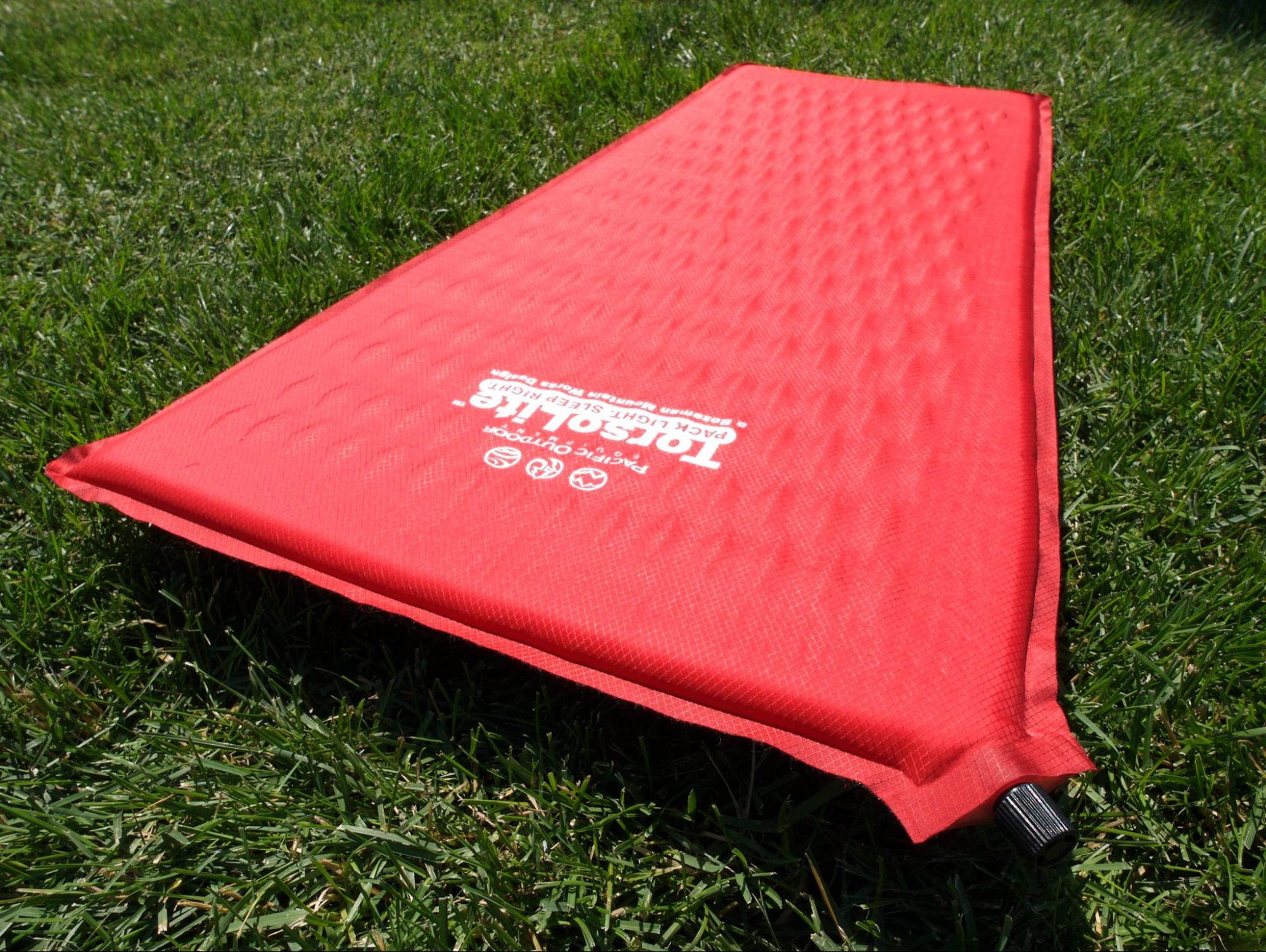
Evolution of the inflatable sleeping pad: leaving foam behind
As you can see from the table above, each of these styles of pads suffers from the following limitations:
- low comfort (thickness)-to-weight ratio
- low warmth (R-value)-to-weight ratio
However, in 2009, Therm-a-Rest introduced the first ultralight, uninsulated, non-self-inflating mattress to the backpacking market, the NeoAir. It was 3 inches (7.6 cm) thick, had an R-value of 2.5, and weighed only 14 ounces (397 g) in a 20 x 72 inch (51 x 183) cm mummy-shaped form factor. Although its weight was unremarkable (it weighed the same as the Z-Lite), its comfort-to-weight ratio certainly exceeded anything else on the market by a long shot.
The design characteristics of the NeoAir mattress that distinguished it from the Prolite mattress were the insulation, mode of inflation, and thickness. NeoAir mattresses were not insulated; they required manual inflation with your mouth or a bellows-style pump sack, and they were thick. That thickness translates to comfort, and it’s this feature alone that has resulted in their growing popularity over the past 15 years.
Since then, non-self-inflating mattresses have become the dominant product category within the overall backpacking sleeping pad market. NEMO, REI, Sea-to-Summit, Big Agnes, Zenbivy, Exped, and Klymit each offer several products within this category.
Some are insulated, some are not. Some are rectangular, others are mummy-shaped. Some are narrow (20 inches / 51 cm wide), some are wide (25 inches / 64 cm or wider). Some are short (down to about 47 inches / 119 cm), some are long (up to about 77 inches / 196 cm). Some are light (as light as 8 ounces / 227 g), some are heavy (as heavy as 40 ounces / 1,130 g). Some are quiet, others are noisy. Some are durable, others are fragile. Some are more stable, others are more wobbly.

This product category, now comprised of dozens of different pads, has become commodified in the past five years or so, and the differences between many of the brands are a bit subtle.
However, two manufacturers – NEMO and Therm-a-Rest – have become market share leaders. The reason for this is two-fold:
- They have invested research and development resources into making these pads warmer using reflective surfaces and baffles (i.e., no foam or other high-loft fill materials).
- The quality of their construction and fabrics is relatively high. They tend to be fairly reliable in terms of seam integrity and fabric puncture resistance.
- They were the first companies to introduce regular length (72 inches / 183 cm), wide (25 inches / 64 cm) pads.
It is this latter feature – the “regular-wide” pad – that has probably changed my sleep comfort more than anything else in recent years. A wide pad is both more stable while sleeping or changing positions, and more comfortable because it provides a platform for resting your arms at your side (back sleeping), or for splaying your arms and legs into more comfortable, natural sleeping positions (side sleeping).
Having slept on more than 25 pads over the past three years, five pads stand out. Two are made by NEMO, two by Therm-a-Rest, and one is from a relatively small brand – Zenbivy. All of them represent each brand’s state-of-the-art models introduced in the past year.
The following table identifies the pads and compares their specifications for regular-wide size options:
Table: High R-Value Sleeping Pads
The following table outlines five sleeping pads worth considering if you’re in the market for a high-value pad. Therm-a-Rest and NEMO are the market leaders. The Tensor and NXT series represent the market’s current state-of-the-art in ultralight sleeping pad insulation combined with durable, lightweight fabrics. The Zenbivy Flex Air is unique for its soft, stretchy fabric surface, and is probably the most comfortable high-R-value pad to lay on with bare skin.
State of the Market: Inflatable Air Pads
One of our big projects right now is investigating the performance (ground comfort and warmth) of sleeping pads. The following chart shows a plot of the top 100 or so pads on the market.
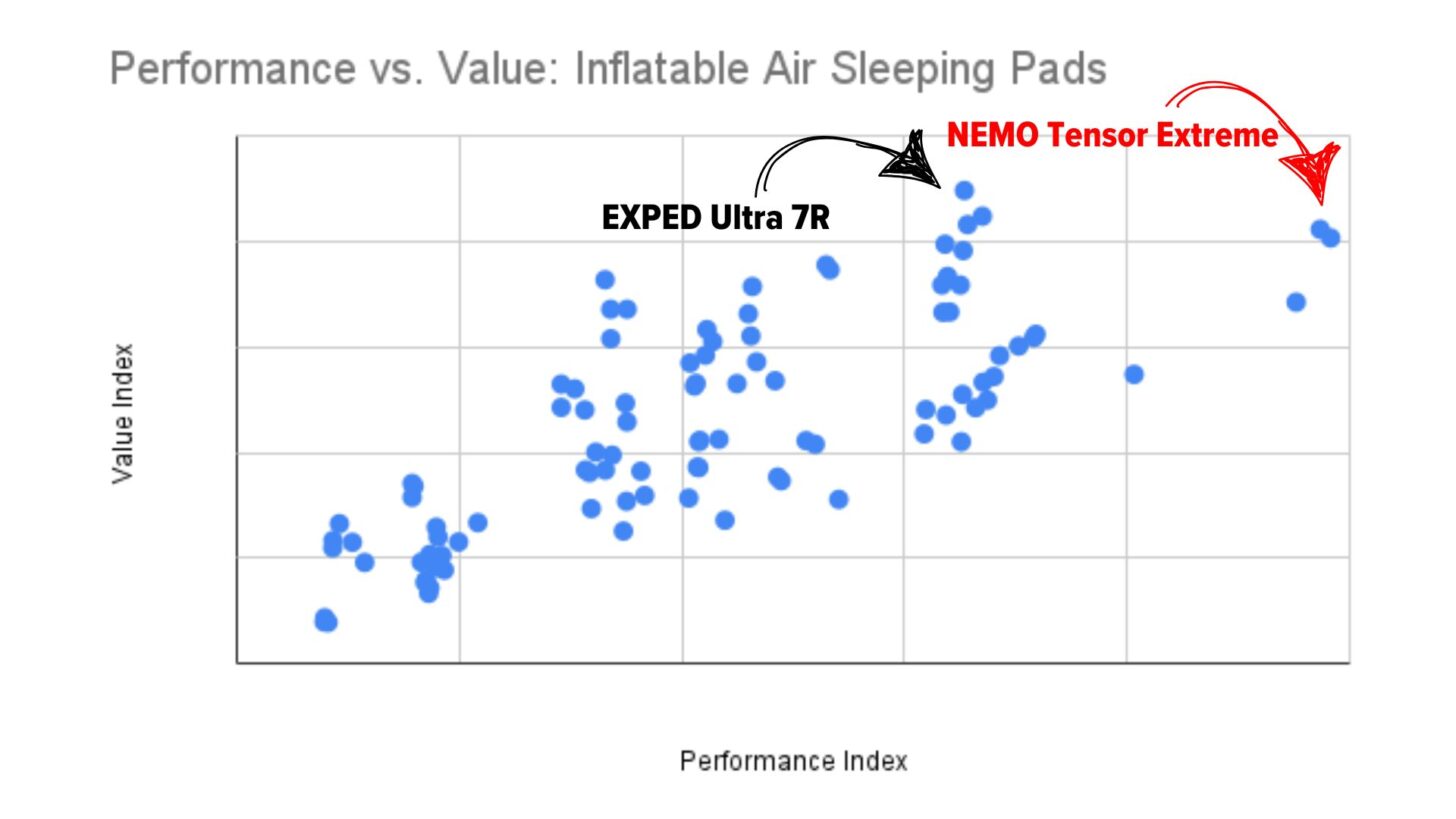
The x-axis (Performance Index) = comfort and warmth per ounce of product. The y-axis (Value Index) = comfort and warmth per dollar of product cost.
In terms of raw performance, the Nemo Tensor Extreme line scores the highest. They offer more performance per ounce than any other pad on the market.
Although they’re expensive, the Nemo Tensor Extreme line provides solid value, dollar for dollar, when compared to other pads. The only product line that scores higher in terms of the raw performance you get per dollar is the Exped Ultra 7R.
If we manipulate the Value Index a little bit, though, and replace the comfort+warmth per dollar of product cost with the comfort+warmth:weight per dollar of product cost, the Big Agnes Rapide SL line floats to the top of the Value chart:
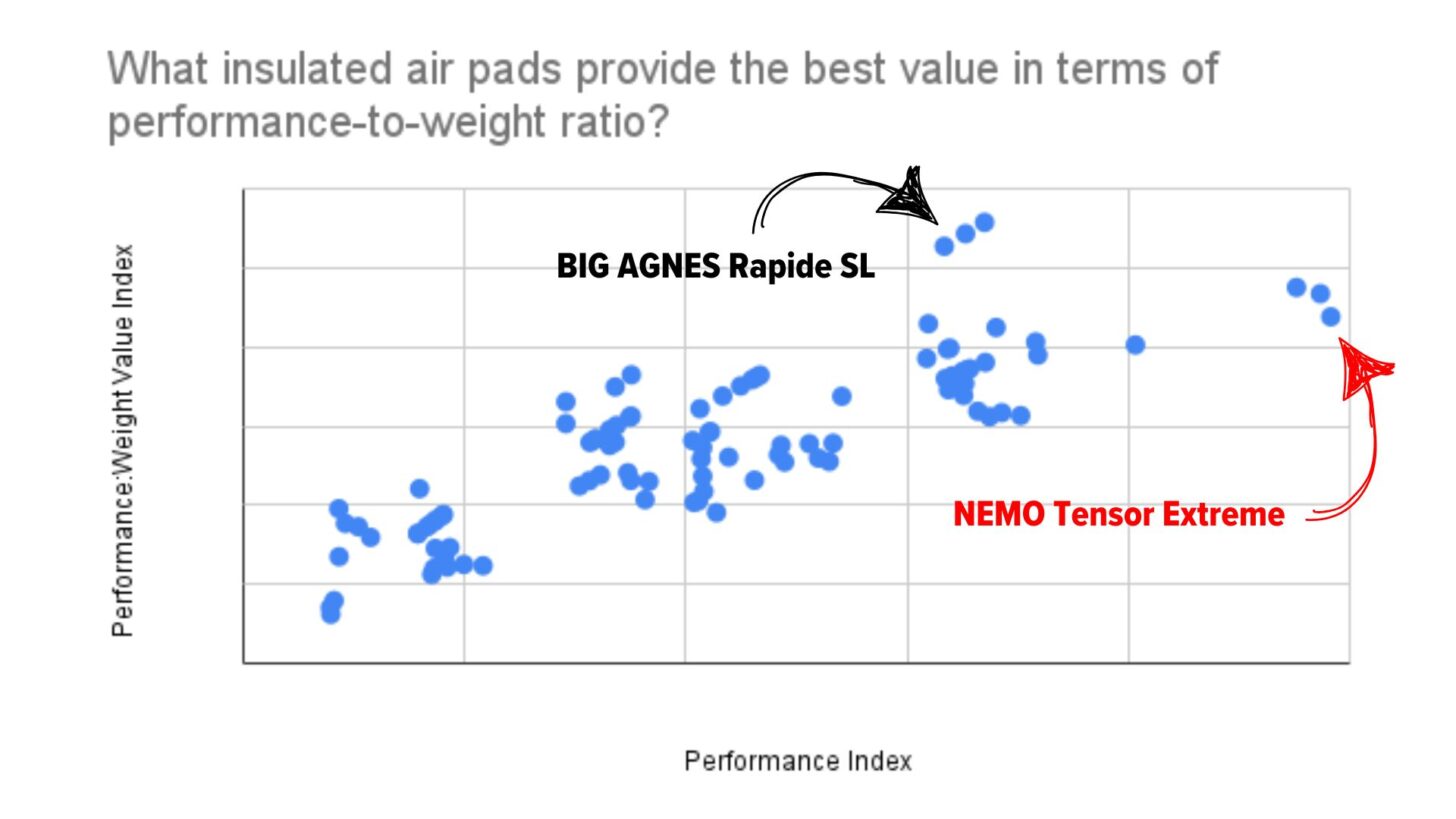
That means the Big Agnes Rapide SL provides the cheapest path towards optimizing your warmth:weight ratio – i.e., it offers the most “bang” for your “buck”.
In short, pads from any of these three product lines will reward you with high performance for their weight, and a lot of value.
This and more data will be published in a forthcoming sleeping pad state of the market report in 2025.
Comfort: stability, warmth, and noise
In field use, my personal preference leans towards the two pads from NEMO – the Tensor All-Season Ultralight Insulated and the Tensor Extreme Conditions Ultralight Insulated. They are quieter and more stable than Therma-a-Rest NXT pads. And while I do think the Therm-a-Rest XTherm NXT is warmer than the NEMO Tensor Extreme Conditions (see below), I find the Tensor Extreme to be sufficiently warm for sleeping on snow in any 3-season condition, and more than warm enough when paired with a Gossamer Gear Thinlight underneath it for winter camping in the Colorado and Wyoming Rockies.
Highly Recommended
NEMO Tensor Extreme Conditions Ultralight Insulated Sleeping Pad
R-8.5 spec is among the highest of any ultralight pad, but the NXT may have a slightly higher warmth-to-weight ratio. The Tensor Extreme is 3.5 inches thick, quieter, and more stable than the NXT. If you could only own one pad for most conditions, this may be the one.
WEIGHT:
17.0 to 23.0 ounces (482 to 652 g)
- quiet
- thick, stable
- warm enough for sleeping on snow
- not a true 4-season pad – may need a thin foam pad for very cold winter use
Maximum warmth-to-weight ratio
If you value pure warmth (as the primary measure of performance) for the weight, the Therm-a-Rest NeoAir XTherm NXT is the new gold standard for warmth-to-weight ratio in inflatable sleeping pads (because of differences in baffle and insulation design, and based on our not-yet-published thermal kettle tests). Considering that it’s a true four-season pad that weighs only 20 ounces (567 g) in a regular-wide size (with a mummy shape), that’s quite a feat. Those who find the horizontal baffling of Therm-a-Rest NeoAir-style pads comfortable can enjoy a few less ounces over the NEMO Tensor Extreme. The only caveat: NXT pads are little noisy (crinkling sound) when moving around on the pad. Tent mates, beware!
Stretch fabrics: soft, quiet, and stable
Finally, there’s one more pad that’s somewhat unique and worth keeping an eye on – the Zenbivy Flex Air Mattress. It’s fairly warm (R-4.8) and fairly light in a regular-wide size (24 ounces / 680 g). Its unique feature, however, is its stretchy top fabric. While it sounds a little strange to put stretch-fabric on a sleeping pad, you may change your mind after lying on top of it. It’s quiet, soft, and the stretch keeps it from wobbling around a bit less when you move around on the pad. The effects are subtle and not earth-shattering, but they are noticeable and may contribute to additional comfort for you.
On a budget?
The lightest premium inflatable pads with the highest R-values and lowest weights approach price tags nearing $300.
With an MSRP of $169 (and a sale price of less than $120 during Memorial Day, Labor Day, and Holiday sales), the REI Helix Insulated Pad strikes a good balance between cost, weight, thickness, stability, quietness, and insulative value.
REI Helix Insulated Sleeping Pad
Similar in warmth (R-4.9) to the Therm-a-Rest XLite NXT (R-4.5), but a more affordable option. The interior baffle design makes this pad impressively stable. Reasonably quiet, reasonably light, and reasonably durable – a very solid budget option with “wide” options in both regular and long lengths for additional comfort.
WEIGHT:
21 to 29 ounces (595 to 822 g)
I’ve purchased, used to failure, dissected, and inspected more than a dozen other pads in the same weight class as the Helix, purchased primarily from white-label brands selling products through online marketplaces (including Amazon, Alibaba, and Temu). These pads ranged in price from $15 to $85. I’ve yet to discover any that meet reasonable quality standards for welded seam consistency, puncture resistance, or fabric QC uniformity. There are marked differences in both material and manufacturing quality between these products and those manufactured by Cascade Designs, NEMO, REI, Big Agnes, Exped, or Sea to Summit. Buyer beware.
Pumps and Pump Sacks
Inflatable sleeping pads have spawned a market for inflation pumps and pump sacks. Most inflatable mattresses include an inflation bag (“pump sack”) that works as follows:
- Attach the bag to the pad’s inflation valve (using the bag’s built-in adapter).
- Fill the bag with air.
- Roll the bag opening over to seal it, and expel the air into the pad like a bellows.
- Repeat steps 2 and 3 until the pad is filled.
- Remove the bag from the pad and top off with a few breaths.
An inflation bag can be filled with air in one of two ways:
- A Bernoulli effect – where you lightly blow air into a narrow opening of the sack, and Bernoulli forces draw additional air inside.
- A scoop effect – where you scoop the inflation bag’s large opening through the air or point it into the wind to fill it up.
Some of us try to take advantage of multiple-use inflation bags, by using them as pack liners or stow bags for other gear. Narrow-mouth bags don’t work well for this, but wide-opening (“dry-bag style”) inflation bags do. One of the most popular options in our community is the Exped Schnozzel.
Usually, an inflation bag can fill a sleeping pad with air with about 4 to 6 bag fills (less for a larger bag like the Schnozzel, more for a smaller bag like those shipped with Zenbivy pads).
However, if you still think that’s too much effort, or you otherwise don’t want to fuss with an inflation bag or use it as a multi-use item, then there are tiny battery-operated and USB-rechargeable pumps available. Most of them weigh less than 5 ounces (142 g), and most of them (especially those available from mega-online-retailers) are junk. I’ve purchased several to test, and they often lack quality construction, water resistance, battery life, and pumping power. Several have failed in the field after only a few days of use. One exception is the truly ultralight Pad Pal, which weighs 9 grams but somewhat inconveniently requires a cabled connection to your USB portable battery charger for operation (there’s no battery included).
If you are looking for a lightweight, quality pump that has good power, long battery life, a fast recharge time, and is durable enough for sustained outdoor use, consider the Flextail Zero Pump.
Flextail Zero Pump
Save your breath, and leave the bulk of an inflation bag at home. One of the few pumps that actually works well and is still very light, with a decent battery life. You’ll get 15 to 25 mattress inflations on a single charge if you use a full-sized mattress.
And our current recommendation for a portable battery charger with a very high charge density-to-weight ratio:
Related
DISCLOSURE (Updated April 9, 2024)
- Product mentions in this article are made by the author with no compensation in return. In addition, Backpacking Light does not accept compensation or donated/discounted products in exchange for product mentions or placements in editorial coverage.
- Some (but not all) of the links in this review may be affiliate links. If you click on one of these links and visit one of our affiliate partners (usually a retailer site), and subsequently place an order with that retailer, we receive a commission on your entire order, which varies between 3% and 15% of the purchase price. Affiliate commissions represent less than 15% of Backpacking Light’s gross revenue. More than 70% of our revenue comes from Membership Fees. So if you’d really like to support our work, don’t buy gear you don’t need – support our consumer advocacy work and become a Member instead.
- Learn more about affiliate commissions, influencer marketing, and our consumer advocacy work by reading our article Stop wasting money on gear.
